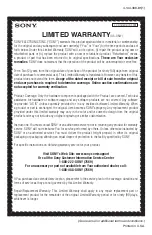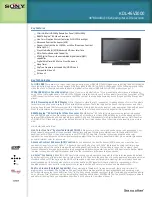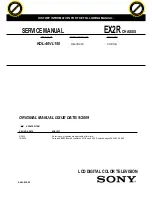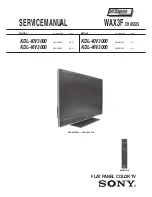
Safety Instructions, Warnings, and Notes
2.
2.
Safety Instructions, Warnings, and Notes
Index of this chapter:
2.1 Safety Instructions
2.2 Warnings
2.3 Notes
2.1
Safety Instructions
Safety regulations require the following
during
a repair:
•
Connect the set to the Mains/AC Power via an isolation
transformer (> 800 VA).
•
Replace safety components, indicated by the symbol
h
,
only by components identical to the original ones. Any
other component substitution (other than original type) may
increase risk of fire or electrical shock hazard.
Safety regulations require that
after
a repair, the set must be
returned in its original condition. Pay in particular attention to
the following points:
•
Route the wire trees correctly and fix them with the
mounted cable clamps.
•
Check the insulation of the Mains/AC Power lead for
external damage.
•
Check the strain relief of the Mains/AC Power cord for
proper function.
•
Check the electrical DC resistance between the Mains/AC
Power plug and the secondary side (only for sets that have
a Mains/AC Power isolated power supply):
1.
Unplug the Mains/AC Power cord and connect a wire
between the two pins of the Mains/AC Power plug.
2.
Set the Mains/AC Power switch to the “on” position
(keep the Mains/AC Power cord unplugged!).
3.
Measure the resistance value between the pins of the
Mains/AC Power plug and the metal shielding of the
tuner or the aerial connection on the set. The reading
should be between 4.5 Mohm and 12 Mohm.
4.
Switch “off” the set, and remove the wire between the
two pins of the Mains/AC Power plug.
•
Check the cabinet for defects, to prevent touching of any
inner parts by the customer.
2.2
Warnings
•
All ICs and many other semiconductors are susceptible to
electrostatic discharges (ESD
w
). Careless handling
during repair can reduce life drastically. Make sure that,
during repair, you are connected with the same potential as
the mass of the set by a wristband with resistance. Keep
components and tools also at this same potential.
•
Be careful during measurements in the high voltage
section.
•
Never replace modules or other components while the unit
is switched “on”.
•
When you align the set, use plastic rather than metal tools.
This will prevent any short circuits and the danger of a
circuit becoming unstable.
2.3
Notes
2.3.1
General
•
Measure the voltages and waveforms with regard to the
chassis (= tuner) ground (
H
), or hot ground (
I
), depending
on the tested area of circuitry. The voltages and waveforms
shown in the diagrams are indicative. Measure them in the
Service Default Mode (see chapter 5) with a colour bar
signal and stereo sound (L: 3 kHz, R: 1 kHz unless stated
otherwise) and picture carrier at 475.25 MHz for PAL, or
61.25 MHz for NTSC (channel 3).
•
Where necessary, measure the waveforms and voltages
with (
D
) and without (
E
) aerial signal. Measure the
voltages in the power supply section both in normal
operation (
G
) and in stand-by (
F
). These values are
indicated by means of the appropriate symbols.
•
Manufactured under license from Dolby Laboratories.
“Dolby”, “Pro Logic”, “Virtual Dolby Digital” and the “double-
D symbol”, are trademarks of Dolby Laboratories.
2.3.2
Schematic Notes
•
All resistor values are in ohms, and the value multiplier is
often used to indicate the decimal point location (e.g. 2K2
indicates 2.2 kohm).
•
Resistor values with no multiplier may be indicated with
either an “E” or an “R” (e.g. 220E or 220R indicates 220
ohm).
•
All capacitor values are given in micro-farads (
μ=
x10
-6
),
nano-farads (n= x10
-9
), or pico-farads (p= x10
-12
).
•
Capacitor values may also use the value multiplier as the
decimal point indication (e.g. 2p2 indicates 2.2 pF).
•
An “asterisk” (*) indicates component usage varies. Refer
to the diversity tables for the correct values.
•
The correct component values are listed in the Spare Parts
List. Therefore, always check this list when there is any
doubt.
2.3.3
BGA (Ball Grid Array) ICs
Introduction
For more information on how to handle BGA devices, visit this
URL:
www.atyourservice.ce.philips.com
not available for all regions). After login, select “Magazine”,
then go to “Repair downloads”. Here you will find Information
on how to deal with BGA-ICs.
BGA Temperature Profiles
For BGA-ICs, you
must
use the correct temperature-profile,
which is coupled to the 12NC. For an overview of these profiles,
visit the website
www.atyourservice.ce.philips.com
subscription, but is not available for all regions)
You will find this and more technical information within the
“Magazine”, chapter “Repair downloads”.
For additional questions please contact your local repair help
desk.
2.3.4
Lead-free Soldering
Due to lead-free technology some rules have to be respected
by the workshop during a repair:
•
Use only lead-free soldering tin Philips SAC305 with order
code 0622 149 00106. If lead-free solder paste is required,
please contact the manufacturer of your soldering
equipment. In general, use of solder paste within
workshops should be avoided because paste is not easy to
store and to handle.
•
Use only adequate solder tools applicable for lead-free
soldering tin. The solder tool must be able:
–
To reach a solder-tip temperature of at least 400°C.
–
To stabilize the adjusted temperature at the solder-tip.
–
To exchange solder-tips for different applications.
•
Adjust your solder tool so that a temperature of around
360°C - 380°C is reached and stabilized at the solder joint.
Heating time of the solder-joint should not exceed ~ 4 sec.
Avoid temperatures above 400°C, otherwise wear-out of
tips will increase drastically and flux-fluid will be destroyed.
To avoid wear-out of tips, switch “off” unused equipment or
reduce heat.
Содержание 32PFL7403D/10
Страница 59: ...Circuit Diagrams and PWB Layouts 59 Q528 2E LB 7 Layout LCD Supply 37 B 42 Top Side H_16750_070 eps 110108 ...
Страница 60: ...60 Q528 2E LB 7 Circuit Diagrams and PWB Layouts Layout LCD Supply 42 Bottom Side H_16750_071 eps 110108 ...
Страница 126: ...126 Q528 2E LB 7 Circuit Diagrams and PWB Layouts Personal Notes E_06532_013 eps 131004 ...








































